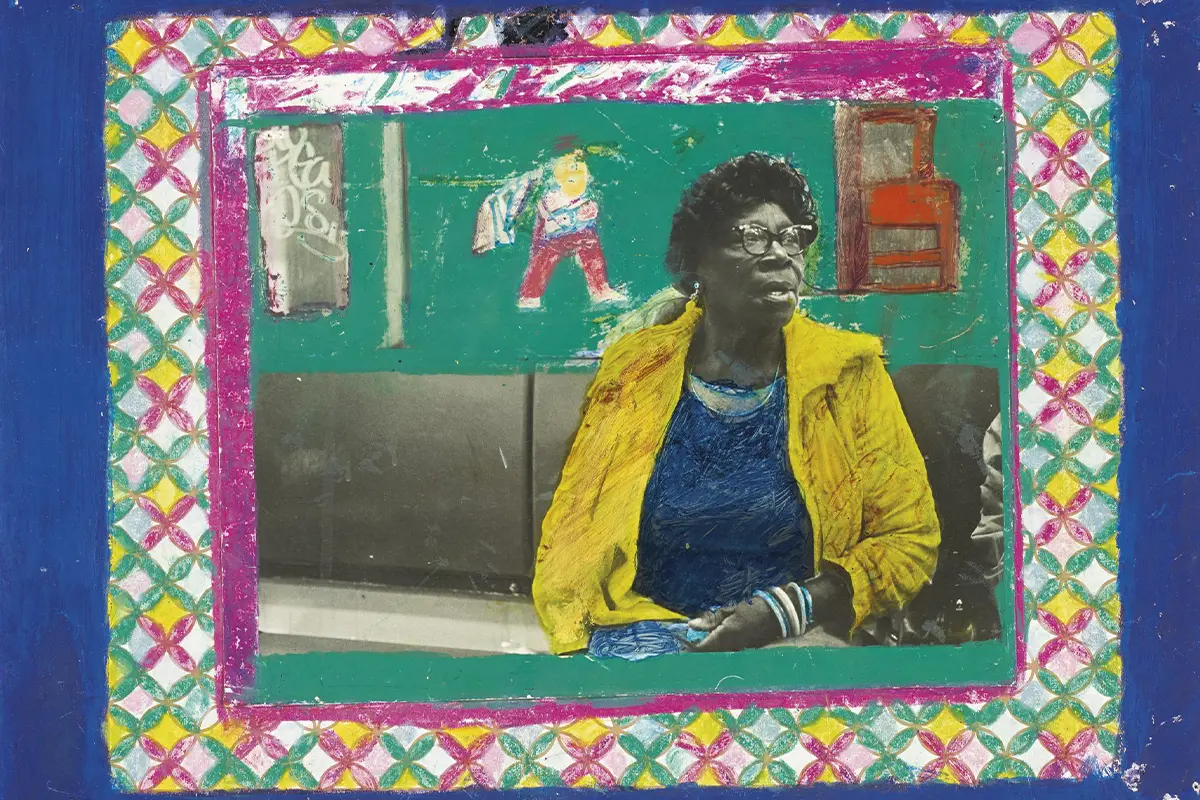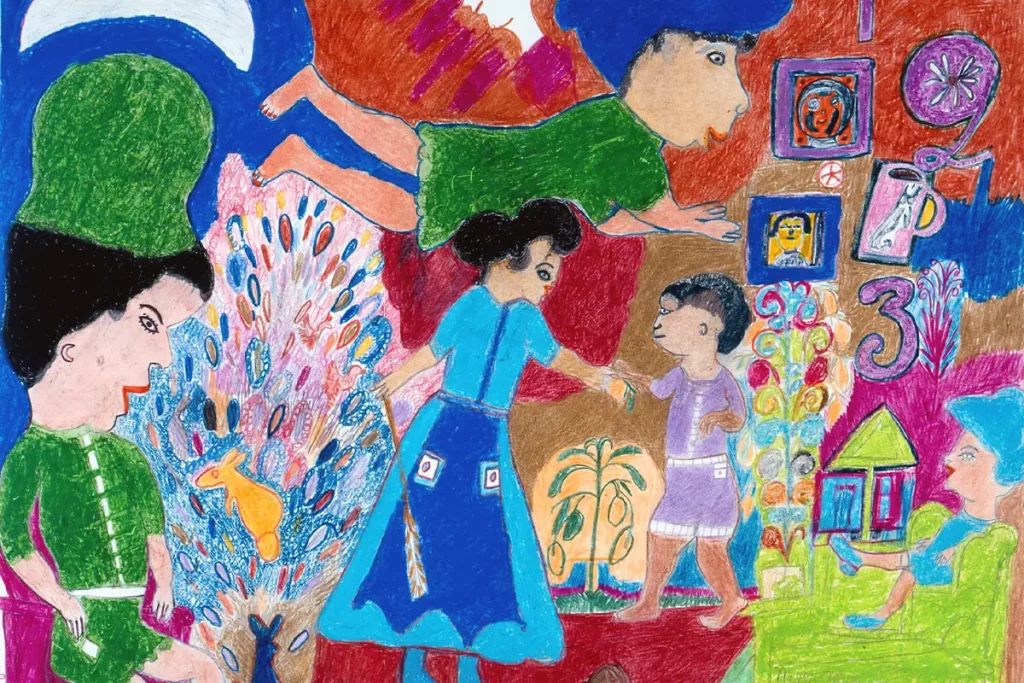From the cotton fields of Georgia to employment as a domestic worker at a white household, black artist Nellie Mae Rowe chronicled the feminist redemption of an African American
Nellie Mae Rowe’s early life and a ‘God-given’ way to illustrate your gratitude for life
Rowe was one of ten children, burdened by her family’s financial pressures, she was forced to leave school in the fourth grade to help work the cotton fields with her father. In addition to managing the cotton farm, her father also worked as a blacksmith and basket weaver. Rowe’s mother Luelle Swanson was an expert seamstress and quilter. Rowe always managed to find time for her arts and crafts projects. Her mother taught her how to create dolls, quilts, and small wooden sculptures.
Her work consisted mainly of mixed media sculptures, drawings, and paintings. Though her work is seemingly characterized by its whimsical and playful nature, Nellie took inspiration from her personal hardships throughout her life. Rowe obtained a talent of taking the most sinister parts of life and turning them into something cheerful and digestible for her audience. Rowe described art as a ‘God-given’ way to illustrate your gratitude for life, as well as a means of recovering from a childhood lost to poverty and struggle.
Rowe’s struggles continued to follow her throughout her life, with the demands of her family’s farm, an early marriage, decades of employment as a domestic laborer and later the death of both her husbands, Rowe found it difficult to create for a long period of time. After the grief of her second husband in 1960, Rowe felt it was time for her to return to her roots and start doing what she felt had always been decided for her.
Politics and context – Nellie Mae Rowe’s African American artistic voice
Although Rowe did not explicitly explore politics through her art, her art can be described as an act of cultural resilience. Through her embrace of radical material exploration, Rowe reclaimed her own narrative and asserted value upon the African American artistic voice.
Through her exploration of identity and depiction of her everyday life in an unconventional manner, Rowe was indirectly challenging social and political structures that marginalized African Americans within the art World.
Rowe’s art can be seen as a celebration of African American heritage, creating a platform for self-expression to blossom. In this way, Rowe’s art contributed to a larger cultural and political conversation around these large themes of; identity, representation, segregation, and social equity.
The Playhouse – Nellie Mae Rowe’s House, 1971
Rowe’s first creation is titled ‘Playhouse’, inspired by her own living space; her home and yard. Embellished with dozens of objects from her every day; dolls, stuffed animals, plates, clothes, and various clutter, her home was suddenly transformed into a living piece of art. Scraps of wood and chewing gum were combined to create sculptures. Recycled and discarded miscellaneous objects served artistic purposes.
When describing her artistic process, Rowe stated, «I started doing it way ago, right after my husband died in 1948 and then people just started to bring me things, bring in dolls, bring me things. I take nothing, you know, take nothing, and make something out of it».
Rowe would later go on to describe this two-cottage space as her ‘playhouse’. This space was where Rowe felt her creativeness had room to flourish and to dream. ‘Playhouse’ went on to become a public attraction in Atlanta, serving as a communal space for Rowe to showcase her work.
In Rowe’s work: flora and fauna, everyday life
«I ain’t gone to school to learn no work like that. I guessed at it when I was a little gal, just lay down on the floor and draw… I just had to get my pencil and draw something».
Nellie Mae Rowe’s art was characterized by several common themes. The first being: everyday life. Rowe was moved by the most mundane of activities, finding her style in taking these common scenes and putting them side by side with fantastical scenes only found in one’s dreams and imagination. Her art celebrated the beauty that exists in ordinary moments.
The second theme was that of: flora and fauna. Animals played a role in Rowe’s art. Often infusing cats, dogs, and birds with human-like qualities. Nature acted as a backdrop for Rowe’s imaginative world to be built upon. Thirdly was that of spirituality and folklore. Rowe’s art, seen more so in her later years, explores her deep spiritual beliefs. Her characters often drew inspiration from that of African American folklore and cultural traditions.
Self-portrait and identity – Nellie Mae Rowe’s art
Lastly is the theme of self-portrait and identity. This served a role in Rowe’s work and her progression in narrative that carries through her art. Rowe occasionally represented herself within her fantastical worlds, providing us with insight into her personal identity.
Each piece was infused with vibrant colors, intricate patterns, and an overall whimsical atmosphere. Rowe’s artworks often brought its viewer into a nostalgic state of childhood longing; evoking Rowe’s own longing for a childhood that was overpowered by struggles of grief and poverty.
Nellie Mae Rowe – Missing Pieces: Georgia Folk Art, 1770-1976
In 1976 Rowe’s drawings were exhibited in Missing Pieces: Georgia Folk Art, 1770-1976. This bicentennial exhibition was held at Atlanta’s Historical society that traveled around the state and was reprised in Washington, DC, during the Smithsonian Institution’s 1978 Live Folk Festival. In 1978, Rowe began working with gallerist Judith Alexander who was the first to give Rowe a solo exhibition in Atlanta. This was shortly followed by a solo exhibit at the New York City Parsons-Dreyfuss Gallery.
With an increased access to new forms of supplies and an unprecedented income from her exhibits, Rowe produced what would later be known as her ‘masterly’ multi figured drawings in the final years of her life. This powerful progression in her artistic journey occurred simultaneously to Rowe’s diagnosis in 1981 of multiple myeloma, which would take her life just a year later.
«If you will ever remember me, I will be glad and happy to know that people have something to remember me by when I’m gone to rest».
Nellie Mae Rowe ‘s final years
Rowe’s artworks from her final years (1978-1981) explore themes of death and spirituality explicitly. She spoke of life with a newfound spiritual optimism, exploring these new ideals through her art, letting her audience, and herself, know that she was comfortable with her impending death. The final works introduce more text into their composition than that of her early works. Their drawing/collaging nature gives the audience a sense of thought tracking, letting us take a closer look into what Rowe was experiencing at this difficult time of her life.
‘Look back in wonder at how i got over’ is said to have been Rowe’s last work. Inspired by the gospel anthem by Mahalia Jackson “How I got over”. Rowe’s choice of the central serpentine is reminiscent of the creature depicted in the book of Exodus, often used in African American religion and visual art to evoke their modern struggle of freedom. Rowe also depicts Moses as a brown man parting the red seas to finally reach the promised land.
High Museum of Art, Atlanta – Really Free: The Radical Art of Nellie Mae Rowe
Really Free: The Radical Art of Nellie Mae Rowe is organized by the High Museum of Art, Atlanta, and curated by Dr. Katherine Jentleson, Merrie and Dan Boone Curator of Folk and Self-Taught Art, High Museum of Art. The Brooklyn Museum presentation is organized by Catherine Morris, Sackler Senior Curator, and Jenée-Daria Strand, Curatorial Associate, Elizabeth A. Sackler Center for Feminist Art, Brooklyn Museum.
Nellie Mae Rowe
Nellie Mae Rowe was an African American artist from Fayette County, Georgia. Although best known today for her colorful works on paper, Rowe worked in a variety of mediums, creating drawings, collages, altered photographs, hand-sewn dolls, domestic installations, and sculptural environments.




















